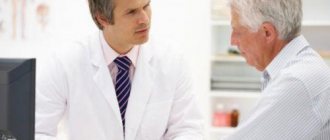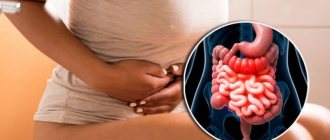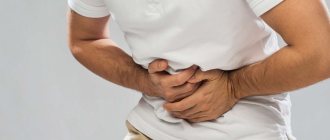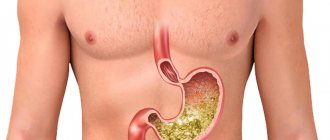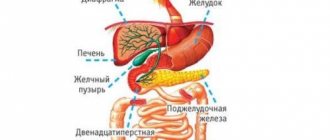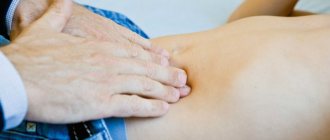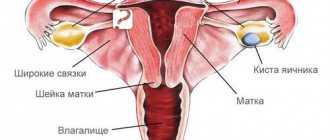home
Symptoms
Tingling in the side
Prices Reviews Our specialists Make an appointment
Tingling pain in the lower abdomen on the left or right is quite common. The appearance of tingling is provoked by minor, quickly passing disruptions in the functioning of the body, which are not dangerous. But this symptom may also indicate serious illnesses. The occurrence of tingling in the side on the right can be caused by increased gas formation in the intestines or a disease that requires immediate treatment. In addition to tingling, each disease is accompanied by other symptoms.
Biliary colic is characterized by discomfort on the right side. In addition to stabbing pain, which occurs more often at night, the patient feels nausea, which turns into severe vomiting and general weakness. He is chilling, there is a constant sensation of noise and ringing in his ears. To get out of this condition, intensive drug treatment is necessary.
What is on the right side of the abdominal cavity?
The content of the article
The abdominal cavity contains many internal organs, the stomach, intestines, pancreas, kidneys, adrenal gland, spleen, liver, pancreas, gall bladder. They are not protected, unlike the heart or lungs, by ribs. They are protected only by the muscles of the abdominal wall (abs).
Problems with any of the organs manifest themselves in the form of tingling, nagging pain and discomfort in various areas of the abdomen. If you experience periodic pain in your right side, you should consult a doctor to determine which organ has problems.
The abdominal cavity consists of 9 parts and is divided into 3 sections:
- Epigastrium
. The epigastrium itself is located directly above the navel. On the right is the subcostal region. - Mesogastrium
. Consists of the peri-umbilical and right lateral regions. - Hypogastrium
. Includes the suprapubic and right iliac region.
Due to the different anatomical structure, pain of the same nature and intensity, localized in the same place, in men and women indicates different diseases.
The following organs are located in the area of the right hypochondrium:
- flexure of the colon of the large intestine;
- right kidney (from the back);
- liver;
- gallbladder;
- right adrenal gland;
- the right half of the diaphragm (the muscle that separates the peritoneum and sternum).
Sometimes pain radiates from organs located elsewhere, for example, from the pancreas or inferior vena cava. In this case, it seems to the person that it hurts on the right side, but in fact the true cause of the pain is in another area.
Pain after eating
Eating accelerates the secretion and movement of bile, increases blood flow to the liver and stimulates intestinal peristalsis. Therefore, food provokes pain in pathologies of the liver, gall bladder, and intestines.
In this case, the nature of the pain can be different: nausea and dull pain are characteristic of cholecystitis, sharp pain of a spastic nature accompanies colitis and intestinal dysbiosis, stabbing pain accompanies biliary dyskinesia or cholelithiasis.
Causes of pain in the right hypochondrium
Pain in the right side of the abdomen does not always indicate any disease. At times they are caused by physiological changes that also happen to completely healthy people.
- Stitches in the side after jogging
or other physical activity. This is typical for unprepared people who are not used to playing sports. Physical activity is stressful for their body, and it reacts with a sharp release of adrenaline. The hormone provokes a spasm of the bile ducts, which stretch from the bile overflowing them. At the same time, the liver fills with blood, increases in size, and the organs press on each other, causing pinpoint pain and tingling. - Tingling in the right side
after a heavy meal. On a full stomach you don’t want to move or move. Under the influence of adrenaline, the inferior vena cava expands and puts pressure on the liver, which is also under pressure from a full stomach. This is why you should not exercise immediately after eating. - Sharp pain in the right side
, radiating to the back. This happens in women shortly before the start of menstruation. Hormonal imbalance causes spasm of the bile ducts, resulting in sharp pain that radiates to the back. It goes away on its own, but causes significant discomfort to the woman. - Pain in the right side during pregnancy
. The uterus, stretched under the influence of the growing fetus, puts pressure on neighboring organs. Also, the hormone progesterone, secreted to relax smooth muscles and prevent miscarriage, provokes stagnation of bile (cholestasis in pregnant women). Many pregnant women experience pain in the right hypochondrium, which intensifies with movement. Therefore, women need to limit their loads and walk more at a slow pace. - Cramps in the lower abdomen (not menstrual)
. Hepatic, renal, and intestinal colic are characterized by irradiation—reflection of the pain signal to another part of the body.
Treatment
Help before diagnosis
Since tingling in the side can be caused by various reasons, it is usually impossible to eliminate the unpleasant symptom without a visit to the doctor. To relieve colic, use antispasmodics or painkillers in accordance with the instructions. If the symptom is accompanied by dyspeptic disorders, the diet should be normalized and provoking foods should be excluded. If you experience severe stabbing pain and deterioration in health, you should immediately seek medical help.
Conservative therapy
To quickly eliminate pain and tingling, specialists in the field of gastroenterology use antispasmodics, which relax smooth muscles, and analgesics from the group of non-steroidal anti-inflammatory drugs, which have a universal effect. The tingling in the side is of medium intensity, so there is no need to resort to strong painkillers or novocaine blockades.
The further course of therapy is selected taking into account the underlying disease. For hepatobiliary pathologies, choleretics and cholekinetics, hepatoprotectors, etiotropic antimicrobial and antiprotozoal drugs are prescribed. To normalize the condition of the intestines, take probiotics, anti-inflammatory drugs (NSAIDs or glucocorticoids), and intestinal antiseptics. To improve digestion, medications with pancreatic enzymes and bile components are recommended.
Physiotherapeutic methods of treatment are effective for relieving chronic pain: SMT and reflexology. To specifically deliver drugs to the lesion, the technique of medicinal electrophoresis is used. Hepatobiliary diseases that occur with stagnation of bile require individual selection of medicinal mineral waters.
Pain in the right side not associated with internal organs
Abdominal pain with depression
. Depression is accompanied by increased anxiety and increased levels of norepinephrine and cortisol. They cause spasms of smooth muscles, including the intestines. The person experiences symptoms characteristic of indigestion. Moreover, this is not associated with eating low-quality food. Abdominal pain cannot be relieved by medications because it is psychosomatic in nature.
A severe and persistent cough also causes abdominal pain
. This is due to the increased load on the abdominals, which not everyone has trained and strong. Often coughing, the patient strains the muscles, they stretch and put pressure on the diaphragm, causing a dull pain. It goes away on its own after the cough is cured.
Other reasons
Other diseases and pathologies, the symptoms of which may include painful sensations of various types in the area of the lower ribs on the right side of the body, are the following:
- From the nervous system: compression of the nerve endings that are located in the intercostal space (intercostal neuralgia), herpes zoster, characterized by acute pain, the appearance of rashes, itching;
- From the digestive system: gastritis, peptic ulcer, various inflammatory processes, intestinal obstruction, colitis, pancreatitis, spasms and pain simulating gynecological diseases, peritonitis, etc.;
- From the urinary system: pyelonephritis affecting predominantly the right kidney (otherwise the pain is localized on the left side, and not in the area of the lower ribs on the right), renal colic, stones;
- From the respiratory system: pneumonia (pneumonia) or bronchitis in acute or chronic course - cough provokes spasms of the respiratory system, which are felt as painful sensations in the right hypochondrium;
- inflammation of the uterine appendages, osteochondrosis, appendicitis, etc.
- From the liver: liver dystrophy, cirrhosis, abscess, hepatitis, hepatitis C and others, heart failure accompanied by stagnation of blood in the liver, and other chronic diseases and acute inflammatory processes.
What can hurt in the stomach on the right?
The causes of pain under the right rib can also be diseases in various organs:
- Liver diseases
: hepatitis (inflammation), hepatosis (metabolic disorders), cirrhosis (replacement of parenchymal cells with connective tissue), liver parasites, metastases as a result of malignant tumors of other organs. - Heart diseases
(they cause circulatory disorders): myocarditis, endocarditis, coronary heart disease, abdominal myocardial infarction. - Gallbladder diseases
: cholecystitis (inflammation), cancerous tumors. - Intestinal diseases: colitis (inflammation of the mucous membrane of the large intestine), Crohn's disease (severe damage to the entire gastrointestinal tract from the throat to the anus), diarrhea, diverticulosis (protrusion of the intestinal mucosa through the muscle wall), irritable bowel syndrome, intestinal infections.
- Diseases of the right kidney
: abscess (purulent inflammation), pyelonephritis (bacterial inflammation), cysts, kidney stones, echinococcosis (presence of helminths in the kidney), tuberculosis (drying) of the kidney, malignant tumor. - Diaphragmatitis (inflammation of the pleura covering the diaphragm).
- Adrenal tumors.
- Intercostal neuralgia (irritation of the intercostal nerves).
- Formation of blood clots in the inferior vena cava.
What to do in case of acute pain
When the lower abdomen and lower back hurt, we often start looking for reviews from other people who have already encountered such a situation in order to understand the reason and determine the course of action for ourselves. It is worth understanding that it is unlikely that you will be able to make an accurate diagnosis for yourself; here you need to immediately seek qualified help from specialists. If the pain is acute and sharp, it is best not to hesitate and call ambulance workers so that you can be examined and brought to the clinic as soon as possible for diagnosis and diagnosis. After this, you will be prescribed treatment, and you can expect an improvement in your condition.
Pain in the right side of the lower abdomen
Often pain in the lower abdomen in women
associated with the onset of menstruation. They are caused by the fact that the uterus is poorly supplied with blood these days, and a situation similar to a myocardial infarction arises. Only in this case does a spasm of the uterine muscle occur.
The intensity of the pain is similar to the cardiac pain during a heart attack. Every sexually mature woman has experienced these sensations at least once in her life, and will not confuse them with anything. The source of pain is localized above the pubic bone, sometimes radiating to the side. This should not cause concern, but the painful sensations should not be tolerated. It is better to take an antispasmodic and be sure to go for an ultrasound. In some cases, too much pain, accompanied by nausea and loss of creation, indicates pathologies of the uterus and ovaries, and requires a mandatory consultation with a gynecologist.
- Pain to the right of the navel
indicates possible appendicitis (inflammation of the appendix - an appendage of the cecum). - Acute cramping pain on the right side
just below the navel indicates inflammation of the fallopian tubes and ovaries (adnexitis) or inflammation of the ovaries (oophoritis), rupture of an ovarian cyst, torsion of a cyst, ectopic pregnancy, urolithiasis and cholelithiasis. The same symptoms indicate a pinched inguinal hernia (protrusion of the peritoneum in the inguinal canal). If you are predisposed to the disease (it occurs in 3% of women and 27% of men), you should immediately call an ambulance. There is a danger of necrosis of the hernial sac. - Aching pain in the right side at the level of the navel indicates inflammation of the small intestine (enteritis), appendicitis, and in the projection of the navel from the back indicates pleurisy - inflammation of the pleura (the serous membrane covering the diaphragm).
Inflammatory diseases of the gastrointestinal tract
Pain and cramps in the right side can be caused by a whole “bouquet” of inflammatory processes in the gastrointestinal tract. “These are, for example, appendicitis, diverticulitis, colitis, gastroenteritis, stomach and duodenal ulcers,” says Bulat Yunusov.
Most often, with these diagnoses, the pain is felt as aching, moderate, with gradually increasing intensity. With appendicitis, pain may increase when walking, coughing, changing body position and decrease at rest. Also with this diagnosis, there is an increase in temperature, nausea, and vomiting.
With a stomach ulcer, the pain becomes more noticeable after eating fatty, spicy or fried foods, alcohol, and intense physical activity. Additional symptoms may include heartburn, nausea, and vomiting.
With colitis (inflammation of the intestines), the pain can be nagging or paroxysmal. The disease is also accompanied by diarrhea, fever, general weakness, headaches, and the presence of mucus in the stool.
With diverticulitis (protrusion of the intestinal walls), acute pain is felt to the right of the navel, the temperature rises, and diarrhea (with blood and mucus) appears.
With gastroenteritis (inflammation of the mucous membrane of the stomach and small intestine), pain in the right side is accompanied by lack of appetite, nausea, vomiting, abdominal cramps, etc.
With pancreatitis (inflammation of the pancreas), the pain begins suddenly and is constant and intense. Sometimes it can “give” to the left side or get worse after eating heavy, fatty or spicy foods.
What to do if there is pain in the right side
For pain in the side, if the doctor cannot “by eye” determine the cause of the ailment, he sends the patient for an ultrasound of the abdominal cavity, ultrasound of the kidneys or ultrasound of the pelvis. Ultrasound waves with a frequency of over 20,000 Hz penetrate the skin into the abdominal cavity, where they are either absorbed by internal organs or reflected back. Special sensors (with abdominal ultrasound) analyze the reflected sound, and based on it, conclusions are drawn about the patient’s condition.
- When tissues become inflamed, they soften and absorb ultrasound more than healthy areas.
- Various lumps, tumors, and stones reflect radiation better, and it can be reliably stated that the cause of the pain is a stone or neoplasm.
- Doppler ultrasound allows you to evaluate the speed of blood flow to exclude compression of the inferior vena cava.
After load
Unpleasant sensations in the form of nagging or stabbing pain occur after physical exertion in people with hepatitis, cirrhosis, or congestive liver. After shaking or physical exertion, an attack of calculous cholecystitis may occur. Also, periodic pain during exercise appears in patients with myositis, intercostal neuralgia, osteochondrosis, rib fractures, and vena cava thrombosis.
Explanation: ultrasound diagnostic results and diseases in the images
| Ultrasound result | Display | Conclusion |
| Hyperechogenicity | Bright areas on the monitor | Seals: gallstones, kidney stones, cirrhosis of the liver, pancreatitis, uterine fibroids, obliteration of nodes (calcifications in nodes) |
| Hypoechogenicity | Dark patchy areas | Inflammatory process: cholecystitis, endometriosis, appendicitis, fibroids, inflammation of the appendages (salpingitis, oopharitis) |
| Anechoicity | Black spots | Free fluid: characteristic of liver cirrhosis, peritonitis, injuries of the liver and spleen, ectopic pregnancy, rupture of an ovarian cyst, ovarian apoplexy. |
If abdominal pain is accompanied by flatulence, ultrasound becomes ineffective.
If inflammation is suspected, the patient undergoes blood tests, and the level of platelets and eosinophils can be used to determine whether there is an inflammatory process in the body.
Pain in acute appendicitis
The appendix is a lymphoid organ that takes part in the immune defense of the digestive system. It is located in the area of the right ilium, but its position is quite variable. This causes difficulties in diagnosing inflammation of the appendix. Appendicitis has its own distinct stages of development, which only a surgeon can diagnose.
Signs of appendicitis are:
- Diffuse pain in the navel and stomach;
- The pain is localized in the right half of the abdomen for three hours;
- Reducing pain when lying on the right side;
- Increased pain when walking and lying on the left side;
- Against the background of pain, general health worsens, body temperature rises, vomiting and diarrhea occur.
In such cases, emergency surgical treatment is performed in a surgical hospital.
